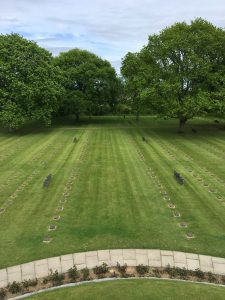Bonjour from Bayeux, France!
The last few days have been an absolute whirlwind. I’m currently writing this on the three hour bus ride between Bayeux and Paris, so hopefully I’m able to recall the majority of what I did in Bayeux the past few days.
May 14th
Our first stop of the day was the Caen Memorial Museum. This museum was interesting because it was split down the middle to denote two eras in 20th century conflict: the WWII era in the Normandy region, and post-WWII history in the Normandy region. My analysis of the museum will not be very thorough, because I never made it to the post-WWII side of the museum. One of my biggest challenges on this trip has been learning time allocation in museums – I just get too absorbed in the reading and the exhibits and completely lose all track of time.

The Caen Memorial Museum
That being said, I only had time to view the WWII and D-Day exhibits at the Caen museum. The WWII exhibit was extremely informative, thanks to a bounty of informational signs and posters that were arranged chronologically to allow people to follow the flow of WWII more easily. The artifacts were not as plentiful as they were at the Imperial War Museum in London, but the artifacts that were there helped tell the story of WWII just as well. The museum separated D-Day into its own exhibit – the operation was so large that it only made sense for there to be a separate exhibit for it in order to explore all of the intricacies of the planning and execution of Operation Overlord. As much as I enjoyed the parts of the museum that I did see, I regret not having allocated enough time to see the other side of the museum, which would have allowed me to have a more thorough interpretation of the museum as a whole.
After we left the Caen Memorial Museum, we took a trip out to the countryside to see the Pegasus Bridge. The capture of this bridge was of vital importance to the Allies. It allowed them to control a critical chokepoint in the road network that made it possible for the Allies to get vehicles, troops, and supplies further into France after the D-Day invasion. The way this operation was carried out was incredible – four Horsa gliders were dispatched to land on a narrow grass strip in between the river and a swamp, just south of the bridge.

The landing site of the Horsa Gliders, near the Pegasus Bridge.
The town near the bridge was controlled and inhabited by German troops, making it extremely risky. The operation went so smoothly that the Allies were able to capture the town and the bridge without a single shot being fired from either side. Seeing this bridge in person really gave me a greater appreciation for just how important this mission was to Allied success in the D-Day invasions. Additionally, as an aviator, I also had a greater appreciation for the skill of the Horsa glider pilots after seeing the “landing strip” on which they were forced to land. To land on such a narrow, short grass strip in the dead of night is extremely daunting and dangerous, and these pilots pulled it off almost perfectly. Reading about these missions in books or listening to lectures about them is one thing, but the significance and magnitude of a mission didn’t really hit me until I was actually there, on the actual ground where the history was made.
May 15th
Coincidentally, the longest and busiest day we had yet also happened to be my favorite day yet in terms of historical sites visited. We began the day with a trip to Utah Beach. Utah Beach looked exactly how I had pictured it in my mind: rolling dunes, dark blue waters muddied by the churn of the sand, a large expanse of beach between the waves and the dunes, and a somber gray sky coupled with a brisk sea breeze to complete the scene.

View of Utah Beach from the dunes.
Seeing Utah Beach like this made it easy to imagine what it would have been like on the day that the Americans stormed the beach, but the feelings that those men must have felt can never truly be recreated. It was an extremely humbling experience to stand on the same beach that was the last thing that many men ever saw. It was hard to not get choked up thinking about the amount of young life lost on that beach, making it ever easier to imagine the waves running red and the beach littered with bodies. As beautiful and peaceful as the beach is now, it is hard to forget the dark history that occurred on those sands.
After visiting the beach, we toured the Utah Beach Memorial Museum just behind the dunes. This museum was surprisingly well planned and full of artifacts from the beach. Artifacts are my favorite part of museums because they are tangible evidence that D-Day actually happened, and each artifact has its own unique story behind it to explain why it ended up in the museum. This museum was not nationality-centric in any way, but was more aimed at education as a whole, making the inclusion of both sides of the fight significant. I did not feel as if the museum was trying to teach a lesson or send a message, but rather that the museum was there simply to show people what happened at that location and to present it in as unbiased of a way as possible. It was nice to tour a museum like this and enjoy it for what it was without trying to find some deeper meaning behind it.
Our next stop of the day was the town of St. Mere Eglise, the first town captured by the 101st Airborne Division on the night prior to the D-Day invasions. The first thing that caught my eye in the town was the massive ancient church and, more surprisingly, a mannequin, dressed as a U.S. soldier, dangling from a parachute at the top of the church.

The church at St. Mere Eglise – note the paratrooper mannequin at the top left of the church.
Naturally, this piqued my curiosity, and I read the various signs to find out more information. Turns out that a man named John Steel, a paratrooper for the 101st Airborne Division, got snagged on the church when his parachute became entangled on the church steeple upon landing in the village. The mannequin was placed there to recreate the scene and to attract tourists to the spot for a good photo op. After a quick lunch in town at a tiny café that played Elvis songs on a loop, we ventured over to the 101st Airborne Museum. Despite the small size, I was taken aback by the abundant number of WWII military uniforms on display, hung proudly on a wide assortment of mannequins, ranging from garish to realistic to downright creepy, and everything in between.

D-Day artifacts recovered from Utah Beach.
The museum also boasted a large number of D-Day artifacts recovered from the beaches and donated by family members of those directly involved with the D-Day invasion. This museum was decisively in favor of the Allies based on the way in which the German artifacts were on display. While the Allied artifacts were on display in eye-catching locations, hung proudly for all to see, the German artifacts were often laid out in cases, as to not attract as much attention as the Allied artifacts. For such a tiny museum, they had a wonderful variety of displays and exhibits and did a fantastic job with making it as immersive and as hands-on as possible.
We once again boarded the bus for a short journey further into the French countryside to visit the Angoville au Plain church and cemetery. It was used as a hospital for both Allied and German soldiers during WWII, making it an extremely unique location, as both sides agreed not to attack this building. One exception to this was when a mortar crashed through the ceiling of the church, but thankfully, the mortar was a dud and did not explode.

The hole in the ceiling from the mortar.
The hole in the ceiling and crack on the tile floor from this mortar are still visible even today. This church was strangely peaceful and relaxing, despite the turbulent history of its location some 70 years ago.

The crack in the floor from where the mortar landed.
The church has been dedicated as a monument and is open to the public so they can view its history for themselves firsthand.
The last location of the day was a quick stop by the German Cemetery at La Cambe. The first thing that drew my attention was the massive line of uniformly spaced trees that lined the outer perimeter of the cemetery. Upon closer investigation, each tree had a plaque placed under it in memoriam to a German soldier who had perished in the Normandy region of WWII. The cemetery itself was extremely imposing, in line with classic German architecture of the time. There were several blocks of graves, denoted by a series of 5 dark black stone crosses, followed by hundreds of smaller, flat gravestones for the multitudes of soldiers buried there.

German cemetery at La Cambe.
In the middle of the cemetery was a massive mound containing the remains of hundreds of unidentified German soldiers. It was topped by a massive black stone monument of a cross, looking down ominously over the rest of the cemetery. This cemetery seemed to send the ominous, foreboding message that war is a terrible thing and should be avoided at all costs. The massive number of graves and dark stones made this message resonate with chilling intensity.
May 16th
This was another marathon day for us, cramming in several important locations into one day. The first stop of the day was Pointe du Hoc, the strategic location that the U.S. Army Rangers were tasked with conquering on D-Day. This location was hands-down my favorite location that we had visited yet for several reasons. Not only was the location extremely scenic, with wide, sweeping views of the English Channel and sheer, vertical cliffs, but because the scene was virtually intact from its D-Day condition. The craters, created by naval artillery shells and mortars, were abundant and scattered throughout the battlefield.

The cliffs at Pointe du Hoc.
The bunkers, created and used by the Nazis, were (mostly) still standing in the condition they had been left in after the fighting had stopped on D-Day. Some bunkers were completely destroyed, reduced to nothing but a pile of rubble, while others were still intact and able to be navigated by the adventurous soul wishing to gain a firsthand glimpse at history. The main gun battery, on the tip of Pointe du Hoc, still had the charred wooden ceilings in place from where the Americans had flamed out all of its Nazi inhabitants, killing everyone inside. Here, history was tangible, palpable, and real.

Ruins of Nazi fortifications at Pointe du Hoc.
Being in the actual location of such a significant battle gives you a much greater appreciation for its significance than learning about it in a classroom ever could. The visit was perfected by not only the beautiful, sunny weather, but by a high-speed low pass performed by a French Air Force fighter jet, clearly showing off for all the visitors. I left Pointe du Hoc feeling refreshed and invigorated by the sea breeze and sunshine, but also with a greater appreciation of the challenges faced by the Army rangers who scaled the cliffs, defeated the Nazis, and helped liberate France.
Our visit to Pointe du Hoc was followed up by a trip to the most infamous beach in the D-Day invasions, Bloody Omaha Beach. Surprisingly, my visit to Omaha beach was in stark contrast to my visit to Utah Beach, and not necessarily in a good way either. The weather at Omaha Beach that day was hot and full of brilliant sunshine, which did not fit the weather conditions of the D-Day invasions in the slightest bit, already ruining the mental picture I had.

Omaha Beach D-Day memorial.
The image was further ruined by the incessant swarms of gnats and flies, which proved to be an unavoidable nuisance for the entire extent of our stay on Omaha Beach. Perhaps the most disturbing part of the visit was the juxtaposition of the beach, the deathbed of thousands of young men, to the multimillion dollar vacation homes, just on the other side of the street, coupled by the screaming French schoolchildren who were using the D-Day memorial monument as their jungle gym. This was extremely upsetting to me for several reasons. One being that I always envisioned the atmosphere at Omaha Beach to be one of heavy sincerity and reverence to the sacrifices made there, when in reality the return to complete normality had taken over in the form of noisy, inconsiderate schoolchildren and commercial development of beach homes and burger shacks. To me, it seemed that the French had attempted to cover up the history of this location in order to make money, completely disregarding the significance of the location aside from the two monuments dedicated to the forces that took the beach back from the hands of evil that day. Try as I might to see Omaha Beach as it was on June 6th, 1944, I cannot. My mind is forever clouded by the image of beach homes and a carefree lifestyle taking precedence over perhaps the most historic moment of WWII that ultimately changed the course of the war, and liberated the country that was taking advantage of its monetarily profitable location.
Feeling sunburned, annoyed, and disappointed, we left Omaha Beach for our final stop of the day, the American Cemetery. Before entering the cemetery, we went through the memorial museum that displayed the story of WWII on exhibit plaques, as well as personal accounts from soldiers in the war. We viewed a short video about the cemetery, during which I felt myself get choked up several times, realizing just how intense this experience was about to be. Upon entering the cemetery, I was immediately overwhelmed with the sheer magnitude of uniform, white marble crosses that were staring me right in the face.

U.S. WWII memorial in Normandy.
The museum said over 9,000 soldiers were buried at the cemetery, but a number that large does not truly resonate with you until you’re standing face to face with row up on row upon never ending row of crosses, beneath which a proud American soldier was buried after giving the ultimate sacrifice. Even thinking about it now, it is hard to not get choked up thinking about these men and the sacrifice they made for their country in a time of need, and it is not hard to see why these people are commonly referred to as The Greatest Generation. This location was the most emotional that I had visited, and after planting the Ohio State flag at the grave of my fellow aviator and Buckeye, Roger Dyer, I found myself wandering the rows of graves, trying to imagine the name on the grave as young man, full of promise for a better future, and not just a name on a grave. It was an extremely humbling experience to be surrounded by so many true American heroes.

Rows upon rows of fallen soldiers.
The American cemetery evoked an entirely difference message than that of the German cemetery. Instead of feeling apologetic, this cemetery exuded resounding American pride and excellence. It was much brighter in color than the German cemetery, and the actual size of the cemetery was much larger, making the cemetery seem like it was making a bolder statement: these headstones should be held in proud regard and seen as honorable sacrifices, rather than as a ominous lesson that war is hell, such as in the German cemetery.
May 17th
This was the “lightest” of the days we were in Bayeux in terms of sites visited and historical lessons learned. We began the day with a break from WWII history to travel back in time to the medieval era of 1077, when the famous Bayeux Tapestry was created. This tapestry, over 230 feet long, was created to tell the story of the Norman conquest of England. While not directly related to WWII history, it was still incredible to see a historical relic that has survived nearly a thousand years in near perfect conditions, despite switching ownership several times and nearly being burned several times. The entire time, I could not shake the feeling that Monty Python and the Holy Grail was based off of this tapestry, and I could almost hear the theme music playing in the background as I toured the museum.
We then boarded our bus and drove out to Arromanches, or Gold Beach, one of the British D-Day invasion beaches.

Arromanches, or Gold Beach. In the distance, you can still see the ruins of the Mulberry Harbor in the water.
Here, we took part in the Arromanches 360 experience, in which we stood in a 360-degree movie theatre room, where scenes from WWII and D-Day were projected in high-definition on 9 different screens and supported by surround sound speaker systems. This experience, while only 20 minutes long, was incredible because it was as close as we could get to living in the moment of WWII era events. I got chills when Hitler’s “Triumph of the Will” speech was projected, his voice booming around us, and thousands upon thousands of German civilians cheering him on were projected on the surrounding screens. It was surreal to be immersed in an experience like that, and truly chilling to experience an extent of what they experienced for only a few moments. The D-Day scenes were even more intense, with explosions and gunfire erupting from all angles. As devastating as WWII was to the world, I would love to be able to travel back in time to experience the world as it was during that extremely pivotal time in history.
May 18th
This day was relatively short in the fact that we only went to one location, Mont Sain Michel, which isn’t really related to WWII history in any way. The island was remarkable to see, and something that was high up on my bucket list after my parents said that it was the one location they missed on their honeymoon to France almost 23 long years ago.

Mont Saint Michel looming in the distance, shrouded by the dense fog.
The history of the island and the abbey itself was incredible, and it looked like something that was straight out of a fairy tale. The weather was absolutely miserable that day, with the fog and rain distracting from the splendor of the location, but the architecture and the history of the buildings made up for the unfortunate meteorological conditions.
Later that day, we had a group dinner at the Duke of Normandy restaurant, courtesy of the generous benefactors of the History of WWII Study Abroad program group. Here we had traditional French food for dinner, the perfect sendoff before our trek to Paris early the next morning.
Overall, Bayeux was a whirlwind of experiences, both of the historical nature and those made in present times. I will never forget the sensation of feeling the cool sand of Utah Beach between my toes, the brisk waters of Omaha beach wash over my feet, and the invigorating sea breeze of Point du Hoc whip through my hair. I will also remember Bayeux as the place where our group of 23 travelers came together as a cohesive unit, bonding over Carrefour baguettes by the pool and enjoying the simple pleasure of watching a French countryside sunset together.

Making friends and memories in Bayeux.
*Posts are obviously a few days behind schedule.
 One glaring thing that I did notice in Poland was its lack of racial diversity compared to the more urban areas that we have visited like London and Paris and even Bayeux. I don’t at all feel like my interactions with people in the city had any racist leanings but I did notice that people would stare at me as I walked through the street. In one instance, it was pointed out to me that as I walked by, a group of school children stopped and pointed amongst each other at me. I imagine that if these children are from rural areas in Poland, it is likely that I could be the first black person that would have seen. It was definitely an interesting change of pace compared previous Columbus and previous areas visited on this trip.
One glaring thing that I did notice in Poland was its lack of racial diversity compared to the more urban areas that we have visited like London and Paris and even Bayeux. I don’t at all feel like my interactions with people in the city had any racist leanings but I did notice that people would stare at me as I walked through the street. In one instance, it was pointed out to me that as I walked by, a group of school children stopped and pointed amongst each other at me. I imagine that if these children are from rural areas in Poland, it is likely that I could be the first black person that would have seen. It was definitely an interesting change of pace compared previous Columbus and previous areas visited on this trip. e. In the moment that they are seen it becomes all too real the horrors that occurred to Jewish people and other outgroups in the Nazi territories. The area that made the deepest impression on me was the room with the shoes from prisoners. The gas chambers which were empty and, while still exuding a deep emotional toll, presented their use without any human element present. This missing human element was probably because previous information had been given about the human toll of the camp and the area was meant to connect that information with the most destructive part of the camp. The room with thousands of shoes left so great an impression on me because it quantified and to some extent, showed the lives of those killed in the camp. The style of shoe could be indicative of the class or gender, even age of a victim of this camp. In that moment it became clear that those were real people who had lives and jobs and people that they loved just like I do and that they were not just some people that I read about in a history textbook.
e. In the moment that they are seen it becomes all too real the horrors that occurred to Jewish people and other outgroups in the Nazi territories. The area that made the deepest impression on me was the room with the shoes from prisoners. The gas chambers which were empty and, while still exuding a deep emotional toll, presented their use without any human element present. This missing human element was probably because previous information had been given about the human toll of the camp and the area was meant to connect that information with the most destructive part of the camp. The room with thousands of shoes left so great an impression on me because it quantified and to some extent, showed the lives of those killed in the camp. The style of shoe could be indicative of the class or gender, even age of a victim of this camp. In that moment it became clear that those were real people who had lives and jobs and people that they loved just like I do and that they were not just some people that I read about in a history textbook.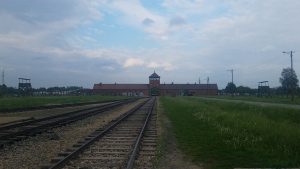


























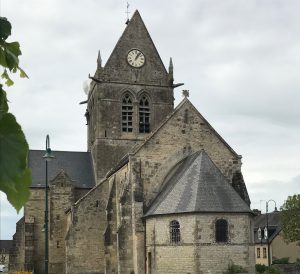





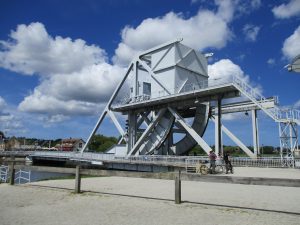
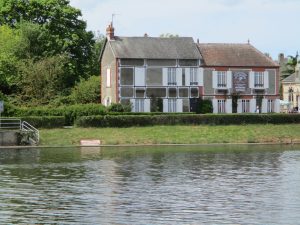










 t had sets of 5 crosses placed sporadically throughout with a large monument in the middle. This site did not seem to be well traveled and had a very somber feel to it. Aside from the lack of people, the small brown graves that were embedded in the ground made the area seem much more open and empty. These graves were also generally honoring two soldiers which added to the magnitude of death that could be felt there. Walking into the American cemetery overlooking Omaha Beach, I was struck by how large it was. There was row after row of white crosses that I think accurately depicted the destruction that the soldiers were faced with during the beach landings. The memorial at the beginning of the museum depicted a muscular man with his arms outstretched.
t had sets of 5 crosses placed sporadically throughout with a large monument in the middle. This site did not seem to be well traveled and had a very somber feel to it. Aside from the lack of people, the small brown graves that were embedded in the ground made the area seem much more open and empty. These graves were also generally honoring two soldiers which added to the magnitude of death that could be felt there. Walking into the American cemetery overlooking Omaha Beach, I was struck by how large it was. There was row after row of white crosses that I think accurately depicted the destruction that the soldiers were faced with during the beach landings. The memorial at the beginning of the museum depicted a muscular man with his arms outstretched. 

































